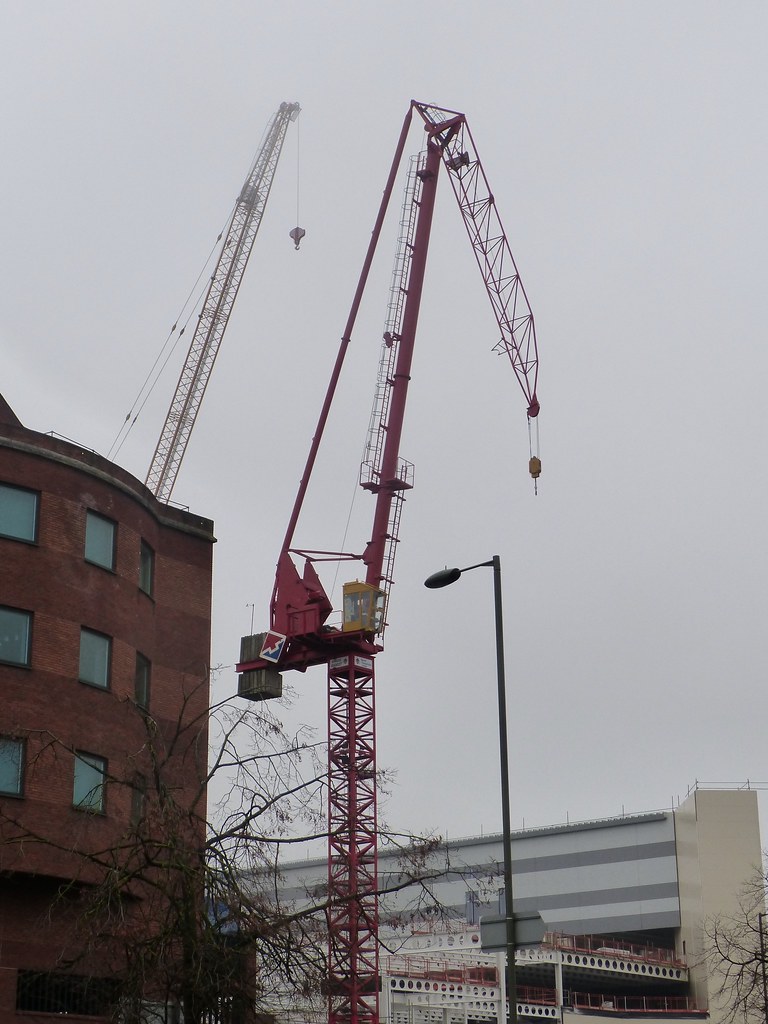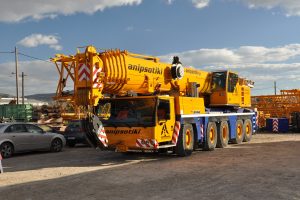
There are different types of cranes used in the building according to the types of work. Now we will discuss in detail the top 10 styles of cranes that are most widely used. Below is the list of the cranes commonly used for commercial purposes.
Static Crane
- Hammerhead Crane.
- Level Luffing Crane.
- Telescopic Crane.
- Tower Crane.
Mobile Crane
- Crawler Crane.
- Rail Road Crane.
- Truck-Mounted Crane.
- Floating Crane.
- Rough Terrain Crane.
- Aerial Crane/Flying Crane.
Static Crane
Dead crane doesn’t reveal any movement as its name suggests. They are classified by the fact that they don’t move from one place to another during their period of use. Mobile cranes are so easy to use and move, but dead cranes have not slightly decreased in importance.
Here are some of the types:
- Level luffing crane
- Self-erecting crane
- Tower crane
- Gantry crane
- Telescopic crane
- Hammerhead crane
- Jib crane
- Stacker crane
- Bulk-handling crane
- Loader crane
- Deck crane
Hammerhead Crane

A fixed jib crane that produces a so-called “racking” motion is the Hammerhead crane or the “Giant cantilever” crane. The type of crane design originated in Germany. In battleships, Hammerhead Crane was used to mounting large pieces such as steel plates, and gun barrels.
Benefits of Hammerhead Crane
- Hammerhead Crane is a fixed-position, static crane.
- Often, they are used for a particular purpose.
Drawbacks of Hammerhead Crane
- They are tough to set up.
- As they’re stuck to the top, it can be a bit problematic to reinstall such a huge structure.
- They are used for mega building purposes only.
Many new hammerhead cranes, though, include a method for shifting and repositioning the suspended container, leading to Giant Cantilever crane flexibility.
Level Luffing Crane

There is a special feature of Level Luffing Crane, which is the crane hook designed to stay at a constant level. Therefore, the crane’s up and down motion just pushes the jib arm towards or away from the crane’s foundation.
Benefits of Level Luffing Crane
- The crane can be positioned relative to the field, to work at a fixed level.
- Because of its features, the load materials can be filled with great precision.
- This enables the jib and the load to stay on the building site ensuring safety for the general public.
Drawbacks of Level Luffing Crane
- It takes longer to execute the necessary moves to lift an object.
- They are impacting construction site efficiency and economy.
In addition, as with all other static cranes, the level luffing crane has its pros and cons, so you have to choose the right type of crane available when planning your project.
Telescopic Crane

Telescopic cranes are another sort of cranes used for the transport of heavy goods, which consists of a wide boom. The boom has tubes mounted inside each other which by means of a hydraulic process raises the height with the help of tubing.
When it comes to shifting artifacts to a high place, telescopic cranes are the best type of crane. They deliver one of the best possible ports-service.
Benefits of Telescopic Crane
- They will change the height to match the venue.
- Due to their height modification, they can be used in rescue operations.
- We are elastic in the context of being versatile in the way we transport goods.
- Cargo embarkation and disembarkation with this form of crane conveniently happens at any terminal of outstanding speed, they push lots.
Drawbacks of Telescopic Crane
- Telescopic cranes are not rotating cranes, necessarily.
But they can often be placed on vehicles, though not fully mobile. The compactness of these cranes renders them perfect for various mobile applications such as short-term construction projects, emergency employment, in- and out-water lifting ships, etc.
Tower Crane

Tower cranes are mostly used worldwide as cranes. It is the form of a balance crane that is fixed to the ground and attached to the structural sides as well. They are, by far, the most used type of crane when it comes to building tall buildings.
Tower Cranes are the world’s biggest cranes. In turn, they are used to bear the biggest and strongest loads on earth.
Benefits of Tower Crane
- The tower cranes exceed any other crane in the world’s loading and raising power.
- No other form of crane will equal their height-capacity.
- We have incredible endurance and can handle the most difficult tasks.
Drawbacks of Tower Crane
- Such cranes are very expensive to move from one location to another and require time, effort and money.
- We have heavy rehabilitation and depreciation maintenance costs.
- We have to mount a significant labor-intensive.
The use of this sort of crane can be of great benefit to industrial construction sites. Nevertheless, the best option is to recruit them, given the cost and performance of the tower cranes.
Crawler Crane
A Crawler Crane is a form of mobile crane that moves along tracks called crawlers. So, the name “Crawler” originates from here. They come with either a telescopic boom or a lattice boom. Without setup, it can move around the site.
The tracks provide stability which allows the crane to operate without the assistance of the outriggers.
Benefits of Crawler Crane
- Thanks to its crawlers, Crawler Crane can travel on any surface of the Earth, even on a soft surface.
- It can be used on vulnerable sites as it distributes the load in a greater area.
- Crawler Crane is driven by one motor and may consist of two or more drums operated by a cable.
Drawbacks of Crawler Crane
- Due to the Crawler Crane’s heavyweight, these machines are moving very slowly.
- It can’t easily be moved from one location to another.
- Because of its features, it isn’t cost-efficient.
But with trucks, it can be moved which can ultimately save some money and make it cost-effective.
Railroad Crane
Railroad Cranes are riding on rail tracks. These are mainly used for the construction and repair and maintenance of railroad tracks. We have three major ends:
- Accident recovery work
- Freight handling
- Permanent way maintenance
Benefits of Railroad Crane
- They are very effective and secure when they travel across roads.
- The potential for loading varies from 15 to 250 tons.
- They have a fast method of self-propelling.
Drawbacks of Railroad Crane
- Because of their flanged wheels, they can not ride on roads or any other location, other than the railways.
Truck-Mounted Crane
A crane mounted on a Truck provides stability for these crane types. It is basically a self-propelled loading and unloading mechanism that consists of a cantilever boom that rotates. This uses the same undercarriage engine as well as a crane.
Benefits of Truck-Mounted Crane
- It can travel on highways.
- Its features facilitate movement and make it less expensive.
- They can be rotated up to 180 degrees, the expensive ones can even rotate 360 degrees on occasion.
- We can be used for a variety of purposes.
- It can be used for engine Truck rolling stock loading and unloading.
- He’s very versatile.
- Truck-mounted cranes move at a height of almost 65 kph.
Drawbacks of Truck-Mounted Crane
- It moves around sites at a low speed but must be transported on the sites.
- They’re usually not used for longer periods of hire.
Floating Crane
Floating Cranes are equipment equipped with a crane specialized in heavy load setting. They’re typically used for construction offshore. These are used in the design of bridges and dock, but can also be used to lift difficult and uncommon loads on and off the container.
The Benefits of Floating Crane
- We can be used in channels, harbors, protected drinks, coastal waters, and the open sea.
- They can be used for charging or unloading sunken ships from the shore.
- We have a total lifting power of 9000 tons.
- They’re easy to carry to the water.
Drawbacks of floating crane
- We are set, and can therefore not be rotated.
Mobile Crane

A mobile crane is a very simple, cable-controlled system attached to its base with a telescopic boom. This appears in various shapes and sizes and can be divided into various types. These cranes are more than a dozen types. Some are mentioned below:
- Sidelifter
- Vehicle-mounted
- Telescopic Handler
- All Terrain
There are many lifting practices, in which it is not practical to use a tower crane. The rigid tower cranes can not perform operations such as monument lifting or indoor lifts. Hence, Mobile Crane is the best solution to such a construction problem.
Remote cranes have to be set up faster. A mobile crane’s greatest advantage is its versatility and ability to access places that static crane can not touch. The Mobile Crane doesn’t need much room. Mobile crane is a simpler alternative for the kinds of big crane styles, so it’s a cost-effective option.
The largest handheld crane in the country is indeed the fastest in the world! The Liebherr LTM 11200-9.1 will carry up to 1,200 tons (equivalent to 12 Blue Whales), rendering it the largest and fastest mobile crane on earth.
Rough Terrain Crane
The rugged terrain crane is the hydraulic crane category subset. It is a self-powered crane which is mounted on four rubber tires. We are designed specifically to work on rough and off-road surfaces.
We are typically used in bridge-building, power and chemical plant processes, and in large-scale projects.
Benefits of Rough Terrain Crane
- The rough terrain crane design makes it capable of maneuvering across surfaces that hinder rubber wheel movement.
- Rough terrain cranes have a longer wheelbase and a bigger motor than cranes on vehicles. The larger center of gravity makes this much more robust than any other crane type.
- All-wheel drive and steering make moving on the raw surface highly efficient.
Drawbacks of Rough Terrain Crane
- One big drawback of using Rough Terrain Crane is that along with other vehicles, it can not be powered on public highways.
- The lowered crane boom continues to obstruct the right and left a vision of the pilot, resulting in a lot of serious incidents.
Those cranes are powered by a single hydraulically operated winch engine. The engine powers the undercarriage as well as the crane.
Aerial Crane/Flying Crane
An aircraft used to lift heavy loads is an aerial crane or moving crane. Often known as “Sky Cranes.” In the logging industry, the most common use of an aerial crane is to raise large trees from remote areas where the terrain is inadequate for the use of ordinary cranes.
Benefits of Aerial crane
- When helicopters fly they are able to reach anywhere and everywhere.
- We will move anything from vessels, vehicles to pools and so on.
- These are best suited to carrying loads to high elevation structures.
- They may be used after a tragedy to carry goods and to unload them for relief purposes to remote areas.
Drawbacks of Aerial crane
- Overloading can result in serious crashes.
- They’re pretty expensive and used for special purposes only.
